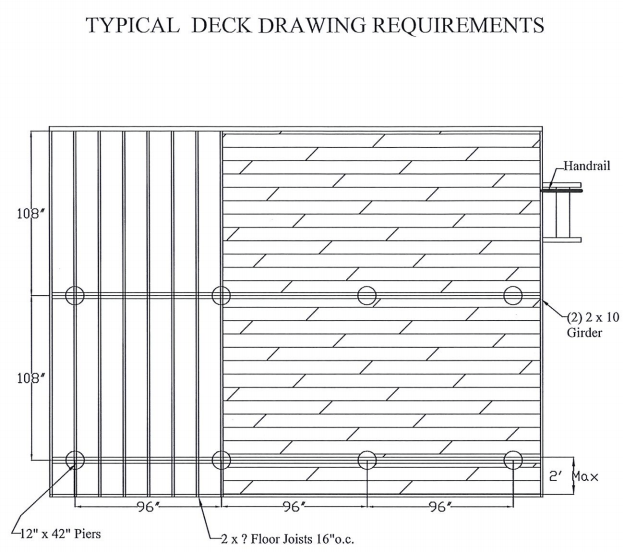Deck Building Guidelines
The City of Niagara Falls requires residents to complete the following guidelines in order to build a deck:
- Building Permit Required:
- A building permit is required for any new exterior deck and shall comply with Section R507 of the 2020 Residential Code of New York State. A copy of a property survey is required to obtain a permit.
- Drawings: Stamped drawing from a design professional required
- A construction drawing, drawn to scale, showing all structural elements will be required for any deck permits. This form outlines the requirements to obtain a permit to erect a deck. All decks and roof structures will require stamped architectural drawings as of April 21st, 2021.

- Footings:
- Must comply with the 2020 Residential Code of New York State, Section R507.3 & Table R507.3.1 The footing must be a minimum of twelve inches (12”) in diameter and at a depth below the frost level of forty-two inches (42”) from finish grade to the bottom of the footing. The footing may also be twelve inches (12”) thick of concrete placed in the bottom of the forty-two inch (42”) hole. The post would extend from the top of the concrete to the bottom of the girder. The backfill material must be well compacted around the post. The diameter of the footing increases with the increase in the size of the post. The footing shall be eight inches (8”) larger than the largest dimension of the post. Footings in flood plain areas shall be twice the diameter.
Example:
4×4 post = 12” in diameter of footing
4×6 post = 14” in diameter of footing
6×6 post = 14’ in diameter of footing
- Lumber:
- All lumber used in the construction of the deck shall be in accordance with R507.2 and be preservative-treated wood or be of natural decay resistant wood (heartwood of redwood, black walnut, black locust or cedar).
- Deck Joist:
- Deck joists must comply with the 2020 Residential Code of New York State, Section R507.6 and be sized in accordance with Table R507.6.

- Cantilever:
- The maximum cantilever allowed by the code is two feet (2’). For longer cantilevers, a set of calculations proving the code design limits and safety of the extended length are being met. These calculations must be signed and sealed by a New York State licensed architect or engineer.
- Landings at Doors:
- R311.3 Floors and landings at exterior doors
- There shall be a floor or landing on each side of each exterior door. The width of each landing shall not be less than the door served. Every landing shall have a minimum dimension of 36 inches (914 mm) measured in the direction of travel. The floor or landing at the exterior door shall not be more than 1.5 inches (38 mm) lower than the top of the threshold. The floor or landing at exterior doors other than the exit door required by Section R311.3 shall not be required to comply with this requirement but shall have a rise no greater than that permitted in Section R311.3 The landing shall be permitted to have a slope not to exceed 0.25 unit vertical in 12 units horizontal (2-percent).
- Exceptions:
- Exterior balconies less than 60 square feet and only accessible from a door are permitted to have a landing less than 36 inches (914mm) measured in the direction of travel.
- The landing or floor on the exterior side shall not be more than 8-1/4 inches (196mm) below the top of the threshold provided the door does not swing over the landing or floor. Where exterior landing or floors serving the required egress door are not at grade, they shall be provided with access to grade by means of a ramp in accordance with Section R311.8 or a stairway in accordance with Section R311 .7
- A top landing is not required where a stairway of not more than two risers is located on the exterior side of the door, provided that the door does not swing over the stairway.
- Metal Connectors:
Any approved metal connector can be used in the locations listed below. All holes in connectors require a nail. Deck screws may not be used on any metal connectors. All nails and connectors used with pressure-treated lumber must be designed for pressure-treated lumber in order to prevent decay of the fastener.
- Post to Concrete Footing
- Post to Girder
- Joist to Girder
- Joist to Ledger Board
- Deck Attachment:
Wood-framed decks shall be in accordance with Section R507.1 or Section R301 for materials and conditions not prescribed herein. Where supported by attachment to an exterior wall, decks shall be positively anchored to the primary structure and designed for both vertical and lateral loads. Such attachment shall not be accomplished by the use of toenails or nails subject to withdrawal. Where positive connection to the primary building structure cannot be verified during inspection, decks shall be self-supporting. For decks with cantilevered framing member’s connections to exterior walls or other framing members shall be designed and constructed to resist uplift resulting from the full live load specified in Table R301.5 acting on the cantilevered portion of the deck. Deck Lateral load connection shall comply with Section R507.9.2.
Handrails and Guards
- R311.7.8 Handrails.
Handrails shall be provided on not less than one side of each continuous run of treads or flight with four or more risers.
R311.7.8.1 Height.
Handrail height, measured vertically from the sloped plane adjoining the tread nosing, or finish surface of ramp slope, shall be not less than 34 inches (864 mm) and not more than 38 inches (965 mm).
R311.7.8.4. Continuity.
Handrails for stairways shall be continuous for the full length of the flight, from a point directly above the top riser of the flight to a point directly above the lowest riser of the flight. Handrail ends shall be returned or shall terminate in newel posts or safety terminals. Handrails adjacent to a wall shall have a space of not less than 1-1/2 inch (38 mm) between the wall and the handrails. - Exceptions:
1. Handrails shall be permitted to be interrupted by a newel post at the turn.
2. The use of a volute, turnout, starting easing, or starting newel shall be allowed over the lowest tread.
- R311.7.8.5 Handrail grip size.
All required handrails shall be of one of the following types or provide equivalent grasp ability:
- Type I. Handrails with a circular cross-section shall have an outside diameter of at least 1-1/4 inches (32 mm) and not greater than 2 inches (51 mm). If the handrail is not circular it shall have a perimeter dimension of at least 4 inches (102 mm) and not greater than 6-114 inches (160 mm) with a maximum cross-section of dimension of 2-1/4 inches(57 mm).
- Type II. Handrails with a perimeter greater than 6-1/4 inches (160 mm) shall provide a graspable finger recess area on both sides of the profile. The finger recess shall begin within a distance of 3/4 inch (19 mm) measured vertically from the tallest portion of the profile and achieve a depth of at least 5/16 inch (8 mm) within 7/8 inch (22 mm) below the widest portion of the profile. This required depth shall continue for at least 3/8 inch (10 mm) to a level that is not less than 1-3/4 inches (45 mm) below the tallest portion of the profile. The minimum width of the handrail above the recess shall be 1-1/4 inches (32 mm) to a maximum of 2-3/4 inches (70 mm). Edges shall have a minimum radius of 0.01 inches (0.25 mm).
- R312.1.1 Guards required.
Guards shall be located along open-sided walking surfaces, including stairs, ramps and landings that are located more than 30 inches (762 mm) measured vertically to the floor or grade below at any point within 36 inches (914 mm) horizontally to the edge of any open side. Insect screening shall not be considered as a guard.
- R312.1.2 Height.
Required guards at open-sided walking surfaces, including stairs, porches, balconies or landings, shall not be less than 36 inches (914mm) in height as measured vertically above the adjacent walking surface or the line connecting the leading edges of the treads.
Exceptions:
- Guards on the open sides of stairs shall have a height of not less than 34 inches (864mm) measured vertically from a line connecting the leading edges of the treads.
- Where the top of the guard serves as a handrail on the open sides of stairs, the top of the guard shall be not less than 34 inches (864mm) and not more than 38 inches (965mm) as measured vertically from a line connecting the leading edges of the treads.
- R312.1.3 Guard opening limitations. Required guards shall not have openings from the walking surface to the required guard height that allow passage of a sphere 4 inches (102mm) in diameter.
Exceptions:
- The triangular openings at the open side of stair, formed by a riser, tread and bottom rail of a guard, shall not allow passage of a sphere 6 inches (153mm) in diameter.
- Guards on the open side of stairs shall not have openings that allow passage of a sphere 4-3/8 inches (111 mm) in diameter.





